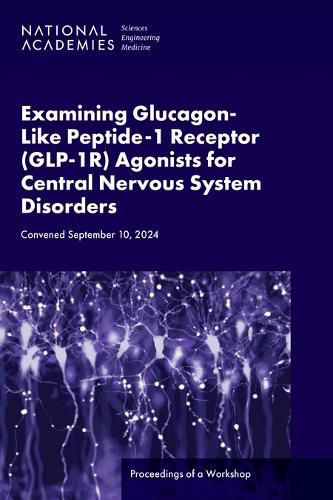Readings Newsletter
Become a Readings Member to make your shopping experience even easier.
Sign in or sign up for free!
You’re not far away from qualifying for FREE standard shipping within Australia
You’ve qualified for FREE standard shipping within Australia
The cart is loading…






Glucagon-like peptide-1 receptor (GLP-1R) agonists, originally developed for type 2 diabetes patients and popularized by their ability to rapidly reduce body weight in patients with obesity, have recently received a lot of national attention. Repurposing GLP-1R agonists to treat some central nervous disorders is promising, but comparatively understudied. At a September 2024 workshop, the National Academies Forum on Neuroscience and Nervous System Disorders reviewed the current knowledge and research gaps about the mechanisms of action of GLP-1R agonists in the brain, and the evidence of their clinical efficacy for eating disorders, neurodegenerative diseases, substance use disorders, and pain.
Table of Contents
Front Matter 1 Introduction and Background 2 GLP-1 Mechanisms in the Brain 3 Learning from Those with Lived Experiences 4 Ingestive Behavior Disorders 5 Substance Use Disorder and Alcohol Use Disorder 6 Neurodegenerative Disorders and Other Emerging Areas 7 Real-World Evidence, Accessibility, and Health Equity 8 Workshop Reflections and Opportunities to Move Forward Appendix A: References Appendix B: Workshop Agenda
$9.00 standard shipping within Australia
FREE standard shipping within Australia for orders over $100.00
Express & International shipping calculated at checkout
Glucagon-like peptide-1 receptor (GLP-1R) agonists, originally developed for type 2 diabetes patients and popularized by their ability to rapidly reduce body weight in patients with obesity, have recently received a lot of national attention. Repurposing GLP-1R agonists to treat some central nervous disorders is promising, but comparatively understudied. At a September 2024 workshop, the National Academies Forum on Neuroscience and Nervous System Disorders reviewed the current knowledge and research gaps about the mechanisms of action of GLP-1R agonists in the brain, and the evidence of their clinical efficacy for eating disorders, neurodegenerative diseases, substance use disorders, and pain.
Table of Contents
Front Matter 1 Introduction and Background 2 GLP-1 Mechanisms in the Brain 3 Learning from Those with Lived Experiences 4 Ingestive Behavior Disorders 5 Substance Use Disorder and Alcohol Use Disorder 6 Neurodegenerative Disorders and Other Emerging Areas 7 Real-World Evidence, Accessibility, and Health Equity 8 Workshop Reflections and Opportunities to Move Forward Appendix A: References Appendix B: Workshop Agenda